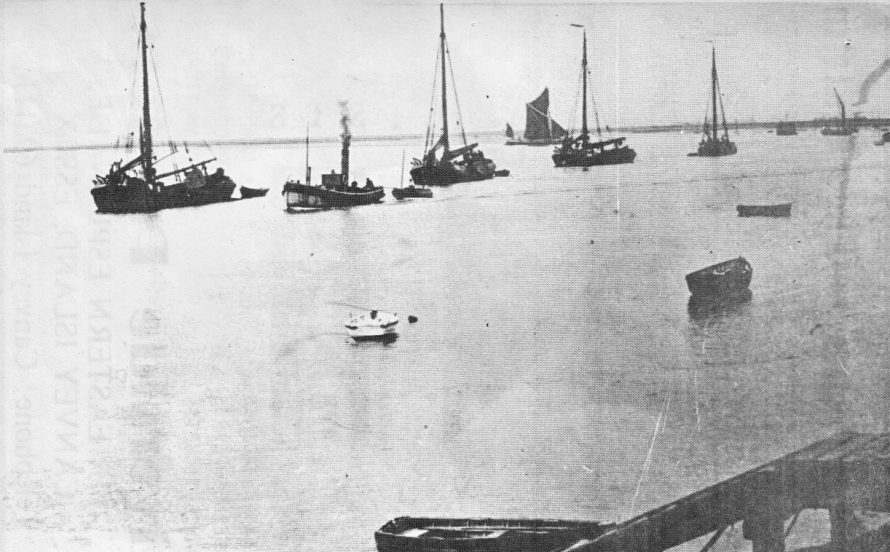Translation passed to the Bulletin by Aubrey Stevens from the Dutch newspaper which recalls a bygone Canvey.

Dutch eel boats in Canvey’s East Haven Creek c1904
“THE CORNER”
No. 85. .
From our Eel out of Friesland – to Billingsgate Fish Market in London.
You speak about Canvey-Island and the Creek, laying dry at low tide near Bumfleet? *
There you have a little village Canvey with a post -office and some shops and a pub “The Red Cow”, and the villagers there have a fine watering-place. Our baiting-place was there the pub “The Lobster Smack” at Holehaven-Creek, from Chas, Buckwheat,** where you could have a fine piece of lobster with a pint of ale. It was very good, I assure you.
Yes, what can I tell you about it. Tradition has it that the Dutch built a dike***round Canvey Island. The dike was a protector against high water in order to make agriculture possible on the landside of the dike. And it is good land there: The English have plenty of dung there of the chalk-cliffs and they are pleased with that dike, constructed in the same way as our dikes.
With low tide our ships were laying in the midst of the waterway, he continued, and with flood they came round, swinging round, on their place again. By high tide the river runs a sight far over the sands, then there is a fall of 12 feet and with spring-tide sometimes 21 feet.
On our question as to adventures in his 24 years of duty most at sea and on board of such small sailing-ships, our “old-master” said: “I don’t like to speak about myself”
In the meantime Mr. De Vreeze’s friend, the old-lockgatekeeper, J.E. de Jong, had “moored alongside” the table, both in their eighties, and they filled a fresh pipe out of the old tobacco-pot. It was after the instance of the yet hale and hearty old Mr. de Jong, who knows all the inland navigation of Friesland and who looked for so many years after the interests of the lockgate of Stavoren that our story-teller
was inclined to tell something about “himsels”.(The Frisian word for himself.)
*Benfleet, of course!
**Charles Beckwith.
***The Dutch always call seawalls dikes.




Comments about this page
Hi Jan
This is very interesting and something of a mystery. I’m sure old Fred knew my Dad well enough to know that he would not have been able to translate this article. He must have been a bit confused. Nobody in our family can remember anything about the Dutch newspaper but if it was in Dad’s possesion it is possible he had it translated and passed it on to Fred. Obviously we can only surmise about the circumstances but we think that locally, the most likely person able to translate would have Greta Gadston (the Dutch lady who used to teach swimming at Leigh Beck school). Until we see Greta or Greta sees this, this cannot be discounted or confirmed. Another more vague possibility is that this could have been something from my great-uncle,Harold Thomas’s effects which he had translated. I know he studied Flemish during his time in Flanders in WW1.
Graham.
I could not help noticing the Stevens connection to this great eye-witness description of old Canvey from an old Dutch newspaper. Surely it must be that same connection that is evident in the Dutch spellings of the poem ‘Snow-White the Red Cow’ by Harold A. Thomas as published elsewhere on this site?
Yes, Robert, after reading some more extracts from Uncle Harold’s letters from Flanders c1918 it would appear that he became quite proficient, if not fluent, in Flemish. Therefore I am even more inclined to believe that this newspaper article was part of his posessions and translated by him . Graham
Add a comment about this page